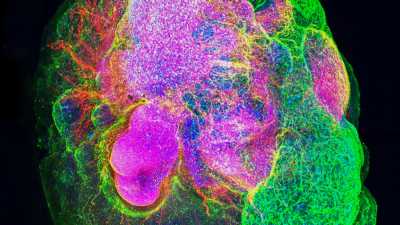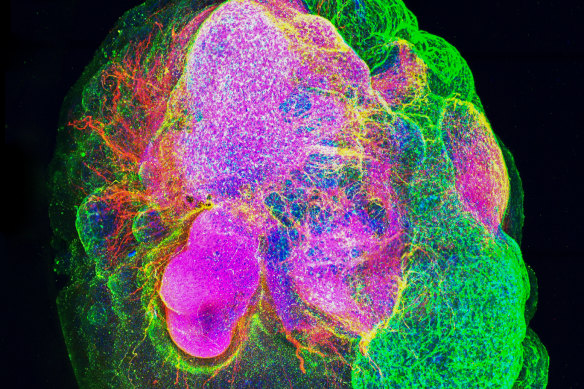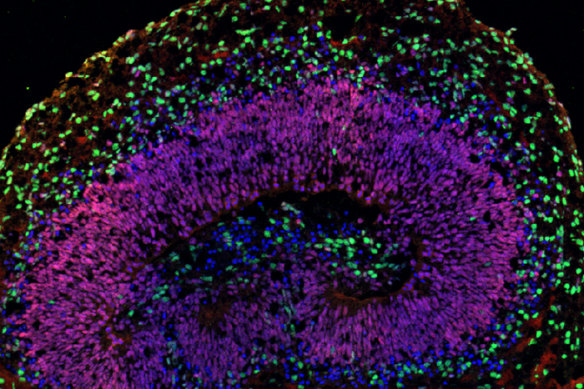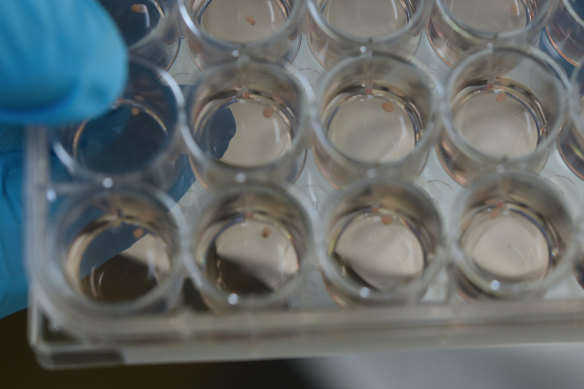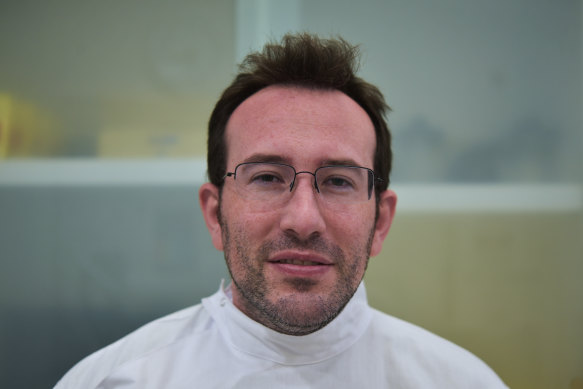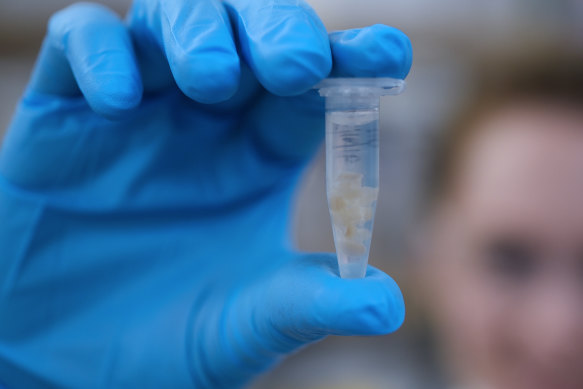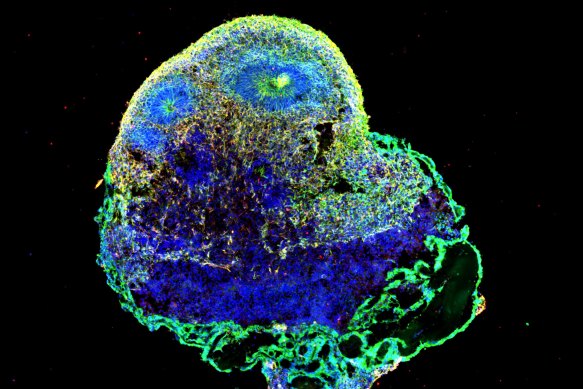Save articles for later
Add articles to your saved list and come back to them any time.
Examine, a free weekly newsletter covering science with a sceptical, evidence-based eye, is sent every Tuesday. You’re reading an excerpt – sign up to get the whole newsletter in your inbox.
Hello! Angus Dalton here, filling in for Liam Mannix. Welcome to Examine.
Today we bring you a tale of mice and mini brains, zombies and zombie hunters, long COVID, and the holy grail – age reversal.
Australian scientists say drugs they have successfully tested on lab-grown brain tissue to kill senescent cells – the “zombies” in this story – could reverse ageing in the human brain and treat cognitive damage caused by COVID.
An example of a brain “organoid” – a bundle of human tissue grown in the lab from stem cells. Researchers from Queensland studied organoids to screen drugs that can flush out damaging “zombie cells” from brain tissue.Credit: The University of Queensland
Senescent cells are cells that stop dividing, healing or operating properly but refuse to die. These zombie cells can be cleared by the immune system, but they also tend to build up naturally as we age.
A developing body of evidence suggests these cells contribute to cognitive decline, disorders such as Alzheimer’s, and potentially the memory loss and brain fog associated with long COVID.
But some drugs, Queensland researchers report in Nature Aging, can eliminate these hordes of zombie cells from brain tissue.
To perform this research, scientists studied brain organoids, or “mini brains”, that they grew from human stem cells. They look like lumpy, fleshy lentils, and they bob around suspended in a liquid media.
Some of the mini brains were infected with COVID, which research shows can cause cellular senescence in the brain.Credit: The University of Queensland
In scientific images, artificially coloured to highlight the organoids’ structures, the mini brains resemble deep sea bioluminescent jellies or vibrant anemones. But they’re bundles of real, human brain tissue – and they make this kind of intriguing research possible.
What kind of zombies are we dealing with?
The lead author of the research, University of Queensland’s Dr Julio Aguado, says that in some ways, senescent cells are comparable to cancer cells.
“They both manage to bypass apoptosis, they resist cell death,” says Aguado, a research fellow at the university’s Australian Institute for Bioengineering and Nanotechnology.
“[Senescent cells] really stay immortal in our body without proliferating and with only one function that is really detrimental for the body, which is that they’re pro-inflammatory.”
The tiny brain organoids used in Dr Julio Aguado’s study.Credit: The University of Queensland/AIBN
Senescent cells can emit inflammatory compounds that damage surrounding healthy cells (like zombies, they devour human flesh), which is why it pays to flush them out.
In an analysis of 54 post-mortem brains last year, researchers found people who had been infected with COVID-19 had higher levels of senescent cells in their brains than those who had not had the virus. The higher levels of zombie cells could explain why infection can accelerate ageing in the brain.
Where do the floating brains come in?
Aguado and his colleagues grew the brain organoids from embryonic stem cells, which can be shaped in the lab to form any kind of cell or tissue.
Aguado’s team let the mini brains age for eight months, so they naturally developed senescent cells. They infected another batch with COVID, and confirmed that the virus triggers senescence in brain tissue.
Then they brought in the zombie-hunting drugs.
Dr Julio Aguado is an expert in studying ageing using brain organoids.Credit: The University of Queensland
They found that four drugs, called senolytics, flushed out senescent cells from organoids, and some almost completely wound back the clock on the “age” of the mini brains and reversed COVID-related damage.
The best treatment was a combination of two drugs: a flavonoid (an antioxidant found in plants) and a chemotherapy drug.
Chemotherapy drugs could be effective on senescent cells, Aguado says, because of their similarities with cancer cells – they’re both malfunctioning cells that resist death.
The drugs also worked in flushing out senescent cells generated by COVID infection, and they reduced the actual amount of virus in the infected mini brains.
The organoids’ 3D structure helps researchers study the effect of drugs on tissue within the body.Credit: The University of Queensland?AIBN
“We have data that supports the idea that senescent cells become a reservoir for the virus,” Aguado explains. “So the virus likes it there. It likes to replicate in senescent cells, specifically.
“Long term, we can expect widespread use of these drugs to treat persistent post-acute infection syndromes caused by viral infections like COVID-19.”
Could the zombie hunters work in a real human?
The benefit of using organoids is that they’re made of human tissue, and they’re a useful stand-in for real brains (as Aguado says, it’s hard to convince clinical trial volunteers to go under the knife for brain biopsies).
But the bobbing mini brains are limited by their simplicity – the ones in this study lacked the network of arteries that nourish a real human brain, for example.
For this reason, Aguado studied the drugs in mice too.
“The level of clearance of cell senescence was remarkable in the brains of these mice. And not only that, we found that mice had barely any virus remaining when we treated them with senolytics.”
The translation of this proof-of-concept research from mini brains and mice to potential human treatment is at least a decade away, and may never come to fruition.
Another brain organoid through the microscope, created with stem cells.Credit: Hannah Leeson, AIBN
And the study of clearing senescent cells for human health is still in its infancy. A clinical trial using senolytics to treat Alzheimer’s recently published the results of its Phase 1 trial, which tested the safety and feasibility of the drugs and only had five participants complete the study.
Phase II will be a more comprehensive randomised trial with a placebo, but it won’t be complete until 2032.
Dr James Kirkland, from the Mayo Clinic in the US, developed the idea that flushing out senescent cells might boost health and brain function. He recently put a figure on how likely it is senolytics, our zombie-hunters, will work on real humans.
“I’ve been around long enough and done enough clinical trials that I still think there’s an 80 per cent chance of failure or a 20 per cent chance they might work,” Kirkland told Longevity Technology.
That might sound dire, but it’s an optimistic view in the realm of medical science – only four years ago Kirkland put the drugs’ chance for success at 0.001 per cent.
The Examine newsletter explains and analyses science with a rigorous focus on the evidence. Sign up to get it each week.
Most Viewed in National
From our partners
Source: Read Full Article
